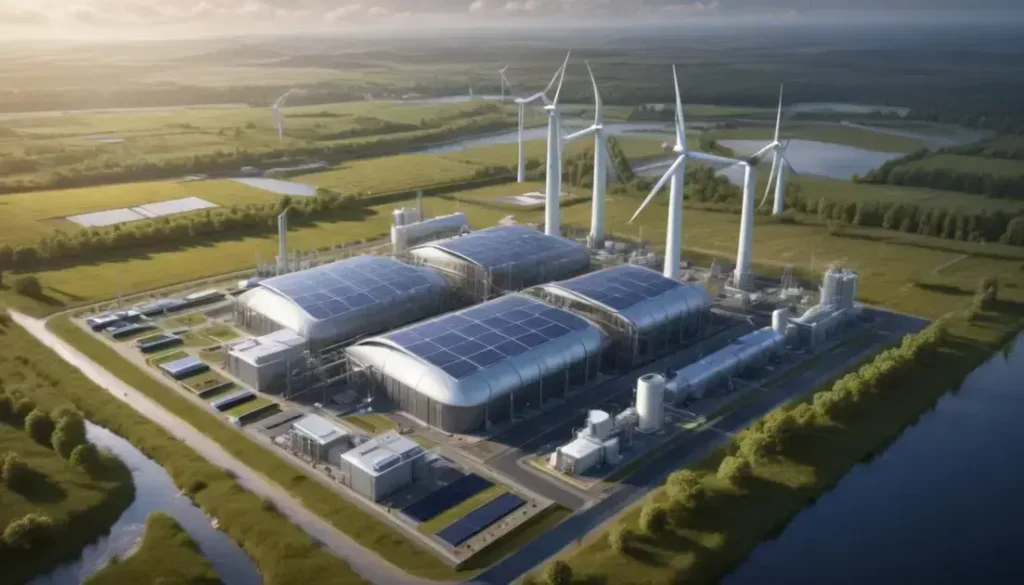Climate change consulting helps organizations develop effective strategies to mitigate and adapt to the impacts of climate change, utilizing data analytics, sustainability reporting, and collaboration to enhance their environmental performance.
In today’s rapidly changing world, the concept of climate change is at the forefront of business discussions. How can companies adapt to this evolving landscape?
Capgemini’s Leadership in Climate Consulting
Capgemini has established itself as a significant player in the field of climate consulting, providing services that address the pressing challenges of climate change. With a commitment to sustainability, the company aids businesses in adapting to new regulations and societal expectations surrounding environmental practices.
One of the key offerings from Capgemini is its expertise in low carbon strategies. These strategies empower organizations to meticulously evaluate their carbon footprint and implement practices that reduce emissions. By leveraging innovative technologies, Capgemini helps firms navigate the complexities of sustainability reporting.
Moreover, Capgemini’s approach emphasizes collaboration and knowledge sharing. By working closely with clients, the consultancy fosters a culture of sustainability that extends beyond compliance. This collaborative model ensures that organizations not only meet regulatory requirements but also achieve long-term goals in resource efficiency and sustainable growth.
Through its comprehensive services, Capgemini is shaping the way businesses view their environmental impact, steering them towards a greener future. The firm underscores the importance of integrating sustainability into the core business strategy, thereby making it an essential aspect of corporate identity.
Innovations in Hydrogen Solutions
Innovations in hydrogen solutions are transforming the energy landscape, positioning hydrogen as a critical player in the transition to a sustainable economy. As nations seek to reduce their carbon footprints, hydrogen is gaining recognition as a clean fuel alternative that can contribute significantly to energy storage and transportation.
Many companies are investing in cutting-edge technology to produce green hydrogen, generated from renewable energy sources like wind and solar. This production method not only minimizes greenhouse gas emissions but also enhances energy security. As the technology matures, the costs of producing hydrogen are decreasing, making it an economically viable option for a wide range of applications.
Furthermore, hydrogen fuel cells are emerging as a promising solution for various sectors, including transportation and industrial processes. By using hydrogen to power vehicles, companies can significantly reduce emissions compared to traditional fossil fuels. This shift could lead to a cleaner air environment and a substantial decrease in urban pollution.
Moreover, governments worldwide are recognizing the potential of hydrogen solutions and are implementing supportive policies and incentives. These initiatives are paving the way for a robust hydrogen economy, ensuring that this innovative energy source becomes an integral part of the global energy mix.
Developing Low Carbon Fuel Strategies
Developing low carbon fuel strategies is becoming increasingly vital for businesses aiming to meet environmental standards and reduce their carbon footprints. These strategies focus on utilizing alternative energy sources that emit fewer greenhouse gases compared to traditional fossil fuels.
One effective approach is the adoption of biofuels, which are derived from organic materials and can be used to power vehicles and machinery. By switching to biofuels, companies can significantly decrease their reliance on petroleum-based products and lower their overall emissions. Furthermore, various advancements in technology are making biofuels more efficient and sustainable.
Another prominent avenue is the integration of hydrogen as a fuel source. Hydrogen can be produced using renewable energy, making it a clean alternative. The growing interest in hydrogen fuel cells for transportation applies this principle, leading to cleaner air and reduced dependence on fossil fuels.
Finally, companies are exploring electric vehicles (EVs) and charging infrastructure as part of their low carbon strategies. As battery technology improves, EVs are becoming more accessible, presenting a viable option for businesses committed to sustainability. By developing comprehensive low carbon fuel strategies, organizations not only comply with regulations but also promote a more sustainable future.
Digital Technologies for Sustainable Practices
Digital technologies play a crucial role in promoting sustainable practices across various industries. These technologies enhance efficiency, reduce waste, and optimize resource management, enabling organizations to meet their sustainability goals more effectively.
One significant innovation is the use of IoT (Internet of Things)
Moreover, cloud computing provides organizations with the ability to streamline their operations while minimizing physical resources. With flexible storage and processing capabilities, companies can reduce their reliance on on-premises infrastructure, leading to lower energy consumption and enhanced scalability. Additionally, digital platforms promote transparency and collaboration among stakeholders. By sharing information on sustainability efforts, businesses can engage customers and partners, fostering a community dedicated to environmental stewardship. Sustainable supply chain management, facilitated by technology, also allows companies to track their materials from raw inputs to final products, ensuring ethical practices and reducing carbon footprints. The impact of digital solutions on supply chains is profound, revolutionizing the way businesses operate in a global market. By integrating technologies such as artificial intelligence (AI), machine learning, and blockchain, companies can enhance visibility and efficiency throughout their supply chains. One key advantage of these digital solutions is the ability to track and manage inventory in real time. This capability allows businesses to respond swiftly to market changes and customer demands. For instance, AI-driven analytics can predict fluctuations in demand, enabling firms to adjust inventory levels accordingly and reduce waste. Moreover, blockchain technology enhances transparency, ensuring that all transactions within the supply chain are secure and traceable. This level of transparency not only builds trust among partners but also helps in identifying inefficiencies and areas for improvement. Additionally, digital solutions facilitate better communication among stakeholders, from suppliers to customers. Enhanced collaboration tools allow for seamless sharing of information, which is crucial for coordinating activities and meeting deadlines. Overall, the adoption of digital technologies is essential for modern supply chain management, enabling organizations to remain competitive and sustainable in an ever-evolving landscape. Measuring sustainability commitments is essential for organizations aiming to track their environmental impact and progress towards sustainability goals. Businesses need clear metrics to evaluate their performance and communicate achievements effectively to stakeholders. One widely-used framework for measuring sustainability is the Global Reporting Initiative (GRI). This framework provides guidelines for reporting on various sustainability indicators, including carbon emissions, water usage, and waste management. By adhering to GRI standards, companies can ensure transparency and accountability in their sustainability efforts. Moreover, key performance indicators (KPIs) play a crucial role in monitoring progress. Companies can establish KPIs tailored to their specific sustainability objectives, such as reducing greenhouse gas emissions or enhancing energy efficiency. Regularly assessing these KPIs allows organizations to make data-driven decisions and adjust strategies as necessary. It is also important for companies to engage stakeholders in measuring sustainability commitments. They can gather feedback and insights from employees, customers, and communities to gain a holistic view of their impact. By integrating stakeholder perspectives, businesses can refine their sustainability goals and enhance their overall effectiveness in promoting a sustainable future. Building a circular economy is essential for reducing waste and promoting sustainable resource use. This economic model emphasizes keeping materials in circulation for as long as possible, minimizing the extraction of new resources and the disposal of waste. At the core of a circular economy is the idea of product life extension. Businesses are encouraged to design products that are durable and easy to repair, which helps reduce the frequency of purchases and decreases waste. This approach not only benefits the environment but also fosters consumer loyalty as customers become more mindful of their consumption. Moreover, recycling and upcycling are critical components of a circular economy. By converting waste materials back into valuable resources, companies can significantly lower their environmental impact. Innovative recycling methods allow industries to reclaim materials that would otherwise end up in landfills, creating a closed-loop system that enhances sustainability. Collaboration among stakeholders is also vital in building a circular economy. Governments, businesses, and consumers must work together to create policies that support sustainable practices and invest in circular initiatives. This collaborative approach paves the way for new technologies and business models that align with sustainability goals, fostering economic growth while protecting the planet. Case studies of successful sustainability transitions provide valuable insights into how businesses can implement effective practices that benefit both the environment and their bottom line. These examples not only showcase innovative approaches but also highlight the challenges and solutions encountered along the way. One notable case is that of a major retail chain that adopted a comprehensive sustainability strategy. By focusing on energy efficiency, waste reduction, and sustainable sourcing, the company significantly reduced its environmental footprint. Implementing renewable energy sources like solar panels across its stores further enhanced its commitment to sustainability, resulting in cost savings and improved public perception. Another compelling example is a manufacturing firm that embraced circular economy principles. This company redesigned its product lifecycle, allowing it to recycle materials and reduce waste. By facilitating a take-back program for used products, the firm not only minimized landfill contributions but also recovered valuable materials for reuse, creating a more sustainable supply chain. These case studies illustrate that sustainability transitions are achievable and beneficial for organizations. They emphasize the importance of collaboration among stakeholders and the need for a long-term vision. By learning from these successful examples, other businesses can develop tailored strategies that align with their sustainability goals and contribute to a healthier planet. Future trends in climate change consulting are poised to reshape how organizations address environmental issues. As the impacts of climate change become more pronounced, businesses are increasingly seeking expert guidance to navigate these challenges. One emerging trend is the integration of data analytics and artificial intelligence (AI) in climate consulting. By utilizing advanced analytics, consultants can provide clients with precise forecasts and actionable insights tailored to their specific climate risks. This approach enhances decision-making and allows organizations to formulate effective climate adaptation strategies. Additionally, there is a growing emphasis on sustainability reporting. As stakeholders demand greater transparency, companies are required to track and report their climate-related metrics. Consultants are stepping in to help businesses establish robust reporting frameworks that comply with evolving regulations and standards, such as the Task Force on Climate-related Financial Disclosures (TCFD). Moreover, collaboration across sectors is becoming more essential. Climate change consulting firms are increasingly partnering with technology companies, non-profits, and government agencies to create comprehensive solutions that address complex environmental challenges. This collaborative approach not only fosters innovation but also promotes sustainable practices across various industries. Understanding and navigating the future of sustainability is crucial for businesses today. From implementing climate change consulting strategies to adopting digital technologies, the path forward is clear. By focusing on innovative practices and collaborating across sectors, organizations can develop effective solutions to address environmental challenges. Sustainability reporting and data analytics also play vital roles in this journey, ensuring transparency and accountability. Ultimately, companies that prioritize sustainability will not only enhance their reputations but also contribute to a healthier planet. By taking these steps, businesses can lead the way toward a greener, more sustainable future. Climate change consulting involves advising organizations on how to mitigate and adapt to the impacts of climate change, helping them develop sustainable strategies. Businesses can measure sustainability efforts through frameworks like the Global Reporting Initiative (GRI) and by establishing key performance indicators (KPIs) specific to their objectives. A circular economy reduces waste by keeping materials in use, ultimately contributing to sustainable resource management and minimizing environmental impact. Technology enhances sustainable practices by providing tools for data analysis, tracking resource usage, and optimizing processes to reduce waste and emissions. Companies can communicate their sustainability commitments through transparency in reporting, engaging stakeholders, and showcasing their initiatives through various media channels. Trends include the use of data analytics and AI, an emphasis on sustainability reporting, and increased collaboration between businesses, governments, and non-profits for innovative solutions.Impact of Digital Solutions on Supply Chains
Measuring Sustainability Commitments
Building a Circular Economy
Case Studies of Successful Sustainability Transitions
Future Trends in Climate Change Consulting
In Summary: Embracing a Sustainable Future
Commonly Asked Questions
What is climate change consulting?
How can businesses measure their sustainability efforts?
Why is a circular economy important for sustainability?
What role does technology play in sustainable practices?
How can companies effectively communicate their sustainability commitments?
What are the trends shaping the future of climate consulting?


